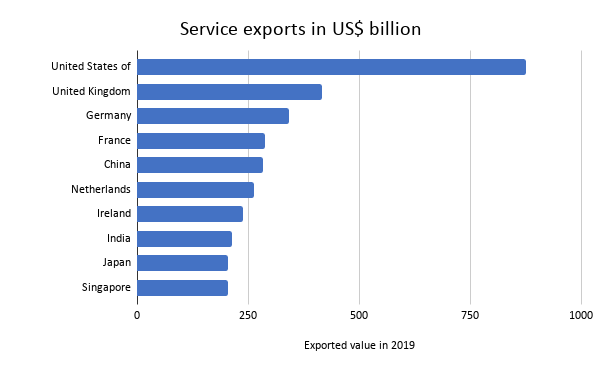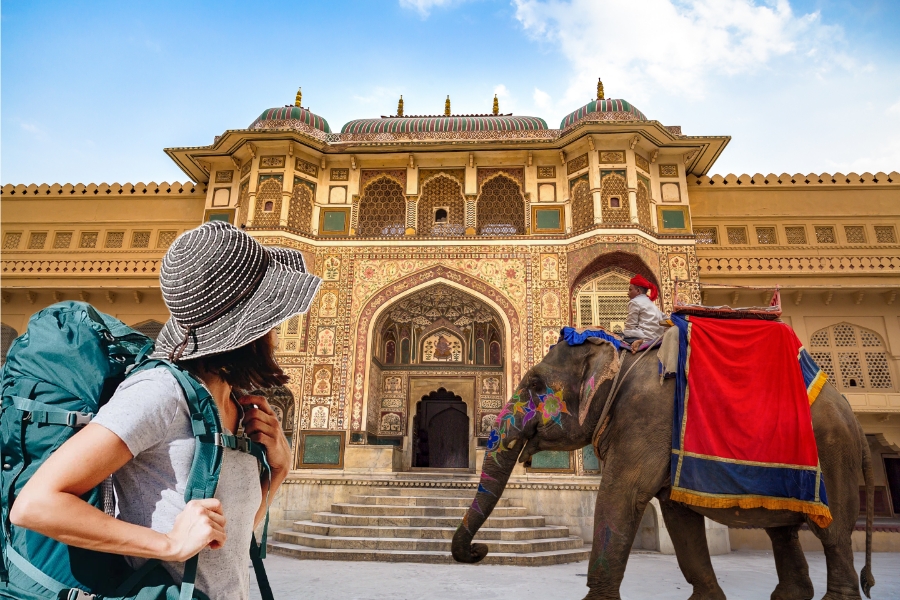Higher education exports: The missing ingredient
India needs to look at ways to improve the quality parameters of its academic programmes, as well as their career orientations to emerge a global higher education hub, as envisioned by the Study in India programme.
- In 2019, global service exports reached their maximum value of US$ 6.1 trillion, before declining in 2020 due to COVID-19 pandemic. International trade in services represents 7% of world’s GDP, which clearly seconds its imperativeness.
- Among developing economies, India is the second largest services exporting economy after China, exporting US$ 214.4 billion. However, it is not a popular global education destination when it comes to global rankings. Top education services exporting countries includes USA, Germany, Netherlands, France, Belgium and Israel.
- Of the total foreign students in India, the highest number came from Nepal (26.88%), followed by Afghanistan (9.8%), Bangladesh (4.38%), Sudan (4.02%), Bhutan (3.82%,), Nigeria (3.4%), the US (3.2%), Yemen (3.2%), Sri Lanka (2.64%), and Iran (2.38%). So, the dominance is from LDCs (least developed nation) or lower and middle developing nations.
- Quality assurance would serve the purpose of setting up the standards of India’s exports to the international audience.

Image credit: Freepik
Around 25 years have passed since the GATS formation, and services have grown over this period to become extremely vital in the field of international trade. In 2019, global service exports reached their maximum value of US$ 6.1 trillion, before declining in 2020 due to the COVID-19 pandemic.
International trade in services represents around 7% of the world’s GDP, which clearly seconds its imperativeness. Among developing economies, India is the second largest services exporting economy after China, exporting US$ 214.4 billion. Let’s quickly have a look at the top ten services exporting economies:

Source: ITC Trade map.
USA exported US$ 875.9 billion worth of services in 2019 followed by UK and Germany. Among total services exports, education services exports, which are the focus of this blog, have a small share (less than 1%, as per UNCTAD statistics). But now, given the new normal after the pandemic, trade in education services is expected to proliferate exponentially.
Education Services
Over the past two decades, the global economy has switched from being manufacturing-oriented to being knowledge and skill driven. This is because as economies move up the ladder of global value chains, the contribution of hi-tech manufacturing and high value-added services to the GDP grows. The significance of higher education in providing these skill sets is indispensable. Therefore, it is vital for India to be one of the pioneers in exporting higher education and to emerge a leader in education services exports.
Study in India has managed to attract 7,500 students over 3 years in higher education. But India does not feature in the list of top education service exporting economies, which features the US, Germany, Netherlands, France, Belgium and Israel. To begin with, lets observe the list of countries from where foreign students come to get higher education in India.
India was the destination country to pursue higher studies for 47,427 foreign students in 2018-19 as per MHRD’s AISHE report. This figure was approximately 7,000 in the year 2000. This is little more than 10% growth rate annually in past nineteen years. Of the total foreign students, the highest number came from Nepal which contributed 26.88% of total incoming foreign students, followed by Afghanistan (9.8%), Bangladesh (4.38%), Sudan (4.02%), Bhutan (3.82%), Nigeria (3.4%), the US (3.2%), Yemen (3.2%), Sri Lanka (2.64%), and Iran (2.38%).
So, the dominance is from LDCs (least developed nation) or lower and middle developing nations. Acquiring human capital is a time and cost intensive affair and any aspiring student expects to get rate of return for these investments, in the form of wages/salaries.
Indian higher education is price competitive compared to developed nations. Since affordability is an important parameter, LDCs represent largest share among incoming foreign students in India. Also, the quality of Indian higher education has a reputation in countries like Nepal, Bangladesh, Bhutan, Afghanistan, Ethiopia, Nigeria, Yemen, Sudan, Iran, etc. So, students coming from these countries prefer India as the rate of return after investing time and money is decent, apart form having a reputed degree.
India’s preferred destinations
The other half of the story will come out eloquently, when we will try to explore the top destinations for Indian students preferring to attain higher education. According to the Ministry of External Affairs, in 2019, approximately 753,000 Indian students studied abroad, out of which the maximum went to the US.
Top destinations for Indian students for higher education
| Nation | Number of Indian students |
| USA | 211,703 |
| Canada | 124,000 |
| Australia | 87,115 |
| UAE | 50,000 |
| New Zealand | 30,000 |
| Bahrain | 27,200 |
| China | 18,171 |
| United Kingdom | 16,550 |
| Germany | 15,308 |
| Philippines | 11,000 |
Source: Ministry of External Affairs, Government of India
Now, a majority of these countries are developed, with high cost attached for acquiring higher education. Still, Indian students prefer to opt for these countries because the average wages/salaries offered are also significantly higher than India on an average. Just to take an example, if an average Indian engineering graduate earns between US$ 6,000 to 8,000 yearly after college in India, then in US with a comparable college, he/she can potentially earn a minimum of US$ 36,000 to 45,000 yearly.
This is one of the major reasons why Indian students aspire to shift to these developed nations even if they need to take a loan for their education. They clearly know that it will be worth taking a loan , considering the expected wage after graduating. So, what exactly happening is we are exporting education services to LDCs and importing it, in much higher quality from developed nations under mode 2 of GATS (consumption abroad).
Missing link
Quality assurance would serve the purpose of setting up the standards of India’s exports to the international audience. These are indicative of a positive trend, wherein a nation becomes both a provider and a recipient of cross border education as a part of the globalisation process, with no major segregation of the economies visible.
Therefore, we have to structurally transform the domestic setup of higher education, which ultimately focuses on quality rather than on quantity. Setting up of private standard universities like Ashoka University and Shiv Nadar University, which maintain the quality of education at par with developed economies is a step in the desired direction.
Going by the number of students in India, the country has quite limited higher educational institutes that operate on high standards. Otherwise, a majority of them need to raise their their game to attract students from developed nations. This cannot be achieved just by signing MoU’s with different universities. There has to be a careful benchmarking with the best in the world on parameters like faculty, campuses, pedagogies, research output, etc. It also requires smart marketing campaigns. For example, Prof Anupam Narula of Amity University, suggests:
The ‘Study in India’ initiative can be achieved by increasing the reach to foreign students through promoting short duration online educational courses on the website . Foreign faculties’ expertise can be used to create multi-disciplinary ‘Nano professional courses” of one to two semesters in architecture, engineering, management, law, medicine, and other disciplines.”
Furthermore, institutes can leverage foreign faculties’ network under the education ministry’s Global Initiative of Academic Network (GIAN) and Scheme for Promotion of Academic and Research Collaboration (SPARC) initiative.
Raising standards of Indian educational institutes, over the long term, will also require an extensive focus on R&D and knowledge output. Besides this, students should have the confidence that they can leverage the skillsets acquired here to launch lucrative careers anywhere across the world. This will bring the key ‘quality’ ingredient and help fulfil the government’s vision to make India a global hub for higher education.
[i] General Agreement on Trade in Services (GATS) covers four modes of delivery of services in cross border trade. Typical examples of trade in Education Services in four modes of supply are as under:
Cross Border Services (Mode 1): Cross Border Supply of Education Services using Technological means.
For example: A teacher may send lesson plans to a US-based college via email.
Consumption abroad (Mode 2): Usage of educational services in the territory of another country.
For Example: Students from US come to study in an Indian college.
Commercial Presence (Mode 3): Expansion of an Educational Institute into a Foreign Country.
For example – An Indian college establishes an additional campus in the US.
Movement of natural persons (Mode 4): Educational Professionals enter into a foreign territory to provide their services. For example- An Indian Teacher teaches in an American college by professionally moving there.













Thanks for the info and good post